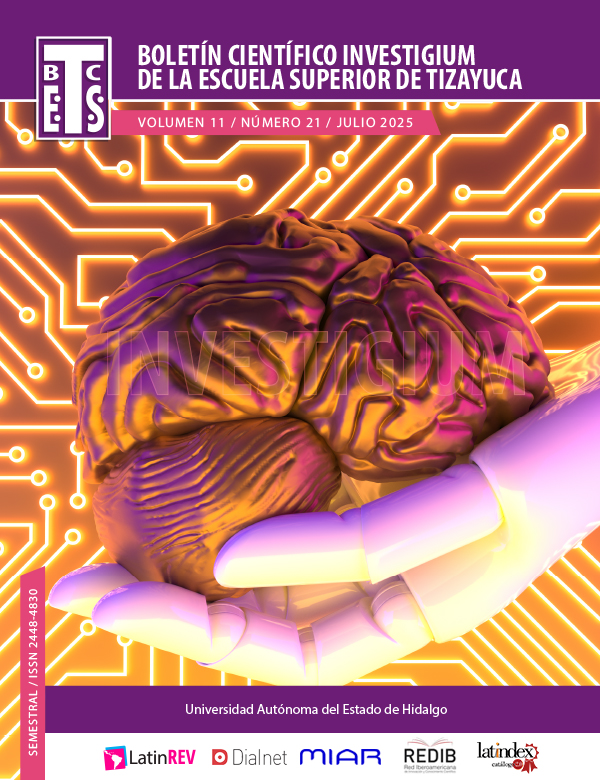Sistema de control para vuelo coordinado de Vehículos Aéreos no Tripulados basado en el drone DJI Ryze Tello® y Rasberry Pi®
DOI:
https://doi.org/10.29057/est.v11i21.13535Palabras clave:
Robótica de enjambre, Vehículo Aéreo No Tripulado, DJI Ryze TelloResumen
El desarrollo de vehículos aéreos no tripulados (UAV) permitirá que en un futuro desempeñen un papel clave, brindando apoyo a diversos servicios. Hoy en día, su aplicación se encuentra en áreas como investigación, agricultura, fotografía y cinematografía, arqueología, entrega de paquetes, entre otros. Los UAV disponibles en el mercado resultan una solución viable para diferentes tareas debido a que disponen de un sistemas de control confiable para la estabilización de vuelo, cámaras a bordo y sensores que permiten controlar el movimiento a realizar, sin embargo, una característica no deseada es su tiempo de vuelo limitado debido a la restricción energética inherente a las baterías que poseen, reduciendo la capacidad de realizar tareas complejas o prolongadas. La robótica de enjambre se presenta como una solución prometedora para abordar estas limitaciones al mejorar la robustez y adaptabilidad del sistema distribuyendo la carga de trabajo entre múltiples drones, aumentando la eficiencia operativa debido a que cada uno podrá realizar una parte de la tarea total, permitiendo que la misión continúe incluso si uno o más fallarán. En este artículo se describe los resultados obtenidos al implementar algoritmos para el control de un enjambre de drones utilizando una plataforma experimental desarrollada para tal fin. La arquitectura de la plataforma está dividida en dos módulos, el de bajo nivel, dedicado al protocolo de comunicación Wi-Fi y envió de comandos entre la tarjeta Rasberry Pi® de control y el drone comercial DJI Ryze Tello®. El segundo módulo de alto nivel, se integra por cada módulo de bajo nivel de los drones que conformaran el enjambre y una tarjeta Rasberry Pi® maestra, cuya función principal es la programación de la misión, la comunicación se realiza a través de una red cableada implementada en un router comercial. Los resultados obtenidos permiten validar que los algoritmos de control y la arquitectura de la plataforma desarrollada son una propuesta eficiente para controlar el vuelo coordinado de drones
Descargas
Citas
Singhal, G.; Bansod, B.; Mathew, L. Unmanned Aerial Vehicle Classification, Applications and Challenges: A Review. Preprints 2018, 2018110601. https://doi.org/10.20944/preprints201811.0601.v1
PS, R., & Jeyan, M. L. (2020). Mini Unmanned Aerial Systems (UAV)-A Review of the Parameters for Classification of a Mini UAV. International Journal of Aviation, Aeronautics, and Aerospace, 7(3), 5. https://doi.org/10.15394/ijaaa.2020.1503
Hejase, M., Noura, H., & Drak, A. (2015). Formation flight of small scale unmanned aerial vehicles: a review. Control Theory: Perspectives Applications and Developments, 221-247. https://doi.org/10.1002/9781634827300ch10
Coppola, M., McGuire, K. N., De Wagter, C., & De Croon, G. C. (2020). A survey on swarming with micro air vehicles: Fundamental challenges and constraints. Frontiers in Robotics and AI, 7, 18. https://doi.org/10.3389/frobt.2020.00018
Liu, Y., & Bucknall, R. (2018). A survey of formation control and motion planning of multiple unmanned vehicles. Robotica, 36(7), 1019-1047. https://doi.org/10.1017/S0263574718000218
Yasin, J. N., Mohamed, S. A., Haghbayan, M. H., Heikkonen, J., Tenhunen, H., & Plosila, J. (2020). Unmanned aerial vehicles (uavs): Collision avoidance systems and approaches. IEEE access, 8, 105139-105155. https://doi.org/10.1109/ACCESS.2020.3000064
Campion, M., Ranganathan, P., & Faruque, S. (2018, May). A review and future directions of UAV swarm communication architectures. In 2018 IEEE international conference on electro/information technology (EIT) (pp. 0903-0908). IEEE. https://doi.org/10.1109/EIT.2018.8500274
Dias, P.G.F., Silva, M.C., Rocha Filho, G.P., Vargas, P.A., Cota, L.P., Pessin, G., (2021), Swarm robotics:A perspective on the latest reviewed concepts and applications. Sensors 21(6), 2062. https://doi.org/10.3390/s21062062
Do, H. T., Hua, H. T., Nguyen, M. T., Nguyen, C. V., Nguyen, H. T., Nguyen, H. T., & Nguyen, N. T. (2021). Formation control algorithms for multiple-uavs: a comprehensive survey. EAI Endorsed Transactions on Industrial Networks and Intelligent Systems, 8(27), e3-e3. https://doi.org/10.4108/eai.10-6-2021.170230
Zhou, Y., Rao, B., & Wang, W. (2020). UAV swarm intelligence: Recent advances and future trends. IEEE Access, 8, 183856-183878. https://doi.org/10.1109/ACCESS.2020.3028865
Rafifandi, R., Asri, D. L., Ekawati, E., & Budi, E. M. (2019). Leader–follower formation control of two quadrotor UAVs. SN Applied Sciences, 1, 1-12. https://doi.org/10.1007/s42452-019-0551-z
Low, C. B., & San Ng, Q. (2011, December). A flexible virtual structure formation keeping control for fixed-wing UAVs. In 2011 9th IEEE international conference on control and automation (ICCA) (pp. 621-626). IEEE. https://doi.org/10.1109/ICCA.2011.6137876
Wang, X., Chen, G., Gong, H., & Jiang, J. (2021). UAV swarm autonomous control based on Internet of Things and artificial intelligence algorithms. Journal of Intelligent & Fuzzy Systems, 40(4), 7121-7133. https://doi.org/10.3233/JIFS-189541
Yan, M. D., Zhu, X., Zhang, X. X., & Qu, Y. H. (2017). Consensus-based three-dimensionalmulti-UAV formation control strategy with high precision. Frontiers of Information Technology & Electronic Engineering, 18(7), 968-977. https://doi.org/10.1631/FITEE.1600004
Do, H. T., Hua, H. T., Nguyen, M. T., Nguyen, C. V., Nguyen, H. T., Nguyen, H. T., & Nguyen, N. T. (2021). Formation control algorithms for multiple-uavs: a comprehensive survey. EAI Endorsed Transactions on Industrial Networks and Intelligent Systems, 8(27), e3-e3. https://doi.org/10.4108/eai.10-6-2021.170230
Arnold, R., Carey, K., Abruzzo, B., & Korpela, C. (2019). What is a Robot Swarm: A Definition for Swarming Robotics. In 2019 IEEE 10th Annual Ubiquitous Computing, Electronics & Mobile Communication Conference (UEMCON)(pp. 0074-0081). https://doi.org/10.1109/UEMCON47517.2019.8993024
Lv, C., Yu, R., Cao, J., Gong, C., Wu, W., & Wang, X. (2022, August). A survey on unmanned aerial vehicle swarm communication and navigation. In International Conference on Guidance, Navigation and Control (pp. 2386-2393). Singapore: Springer Nature Singapore. https://doi.org/10.1007/978-981-19-6613-2_232
Wickramasinghe, O. E., Rajan, N., Wanniarachchi, C., Karunanayaka, K., & Wimalaratne, P. (2024, June). Evolution of Formation Control Algorithms for Unmanned Aerial Vehicles. In 2024 IEEE 33rd International Symposium on Industrial Electronics (ISIE) (pp. 1-7). IEEE. https://doi.org/10.1109/ISIE54533.2024.10595718
DJI-SDK, Tello-Python, (2018), GitHub repository, https://github.com/dji-sdk/Tello-Python
D.F.Escoté, djitellopy, (2024), GitHub repository, https://github.com/damiafuentes/DJITelloPy
hanyazou, Tellopy, (2018), GitHub repository, https://github.com/hanyazou/TelloPy
Ezra Fielding, easyTello, (2019), GitHub repository, https://github.com/ezrafielding/easyTello
Anqi Xu., (2004). tello_driver, Repositorio en GitHub. https://github.com/anqixu/tello_driver
Clyde McQueen, (2019). tello_ros, Repositorio en GitHub. https://github.com/clydemcqueen/tello_ros
YocoZuna, (2023). Tello_Drone_In_Gazebo, Repositorio en GitHub. https://github.com/YocoZuna/Tello_Drone_In_Gazebo
Descargas
Publicado
Cómo citar
Número
Sección
Licencia
Derechos de autor 2025 Gerardo Loreto-Gómez

Esta obra está bajo una licencia internacional Creative Commons Atribución-NoComercial-SinDerivadas 4.0.


















